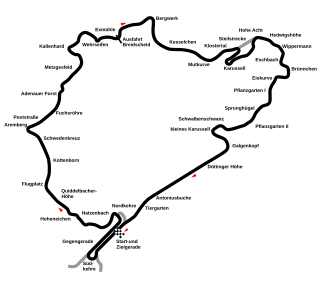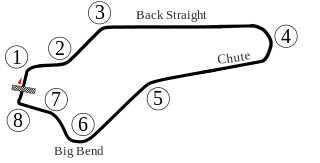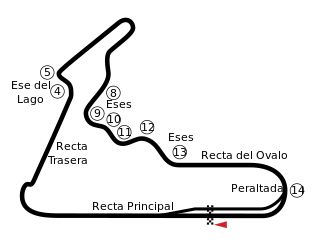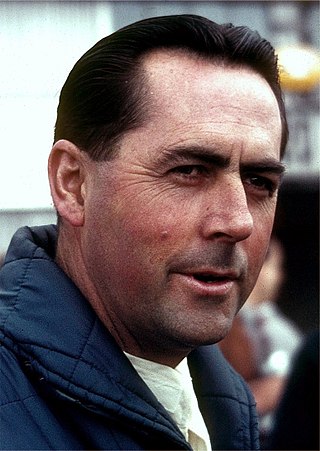
The 1959 Dutch Grand Prix was a Formula One motor race held at Zandvoort on 31 May 1959. It was the ninth Dutch Grand Prix. The race was held over 75 laps of the four kilometre circuit for a race distance of 314 kilometres. It was race 3 of 9 in the 1959 World Championship of Drivers and race 2 of 8 in the 1959 International Cup for Formula One Manufacturers.

The 1961 German Grand Prix was the 23rd time the German Grand Prix motor race was held. The race also held the honorary designation of the 21st European Grand Prix. It was run to Formula One regulations as race 6 of 8 in both the 1961 World Championship of Drivers and the 1961 International Cup for Formula One Manufacturers It was held on 6 August 1961 over 15 laps of the giant 14.2 mile Nürburgring Nordschleife circuit for a race distance of almost 213 miles. The race also celebrated the 100th race since the establishment of the World Championship in 1950.

The 1961 United States Grand Prix was a Formula One motor race held on October 8, 1961, at the Watkins Glen Grand Prix Race Course in Watkins Glen, New York. It was the eighth and final race in both the 1961 World Championship of Drivers and the 1961 International Cup for Formula One Manufacturers.

The 1962 French Grand Prix was a Formula One motor race held at Rouen-Les-Essarts on 8 July 1962. It was race 4 of 9 in both the 1962 World Championship of Drivers and the 1962 International Cup for Formula One Manufacturers. The race was won by Dan Gurney, his first Formula One victory, driving a Porsche, that company's only win as a constructor in a Formula One championship race coming after three years of racing. It was the third time that the French Grand Prix was held at Rouen, the previous time being 1957.

The 1962 German Grand Prix was a Formula One motor race held at the Nürburgring on 5 August 1962. It was race 6 of 9 in both the 1962 World Championship of Drivers and the 1962 International Cup for Formula One Manufacturers. The 15-lap race was won by BRM driver Graham Hill after he started from second position. John Surtees finished second for the Lola team and Porsche driver Dan Gurney came in third. The race was notable for having six different constructors taking the first six positions.

The 1962 United States Grand Prix was a Formula One motor race held on October 7, 1962, at the Watkins Glen Grand Prix Race Course in Watkins Glen, New York. It was race 8 of 9 in both the 1962 World Championship of Drivers and the 1962 International Cup for Formula One Manufacturers. The 100-lap race was won by Lotus driver Jim Clark after starting from pole position. Graham Hill finished second for the BRM team and Cooper driver Bruce McLaren came in third.

The 1966 United States Grand Prix was a Formula One motor race held on October 2, 1966, at the Watkins Glen Grand Prix Race Course in Watkins Glen, New York. It was race 8 of 9 in both the 1966 World Championship of Drivers and the 1966 International Cup for Formula One Manufacturers. The race was the ninth United States Grand Prix. It was the sixth to be held at Watkins Glen. The race was held over 108 laps of the 3.78-kilometre circuit for a total race distance of 408 kilometres.

The 1966 Mexican Grand Prix was a Formula One motor race held at the Ciudad Deportiva Magdalena Mixhuca on 23 October 1966. It was race 9 of 9 in both the 1966 World Championship of Drivers and the 1966 International Cup for Formula One Manufacturers. The race was the fifth Mexican Grand Prix and the first to be run under the new three-litre Formula. It was held over 65 laps of the 5 km (3.1 mi) circuit for a race distance of 325 km (202 mi).

The 1989 FIA Formula One World Championship was the 43rd season of FIA Formula One motor racing. It began on 26 March and ended on 5 November. Alain Prost won his third Drivers' Championship, and McLaren won the Constructors' Championship.

The 1967 Formula One season was the 21st season of FIA Formula One motor racing. It featured the 18th World Championship of Drivers, the 10th International Cup for F1 Manufacturers, and six non-championship races open to Formula One cars. The World Championship was contested over eleven races between 2 January and 22 October 1967.

The 1966 Formula One season was the 20th season of FIA Formula One motor racing. It featured the 17th World Championship of Drivers, the 9th International Cup for F1 Manufacturers, and four non-championship races open to Formula One cars. The World Championship was contested over nine races between 22 May and 23 October 1966.

The 1964 Formula One season was the 18th season of FIA Formula One motor racing. It featured the 15th World Championship of Drivers, the 7th International Cup for F1 Manufacturers, and eight non-championship races open to Formula One cars. The World Championship was contested over ten races between 10 May and 25 October 1964.

The 1963 Formula One season was the 17th season of FIA Formula One motor racing. It featured the 14th World Championship of Drivers, the 6th International Cup for F1 Manufacturers, and numerous non-championship Formula One races. The World Championship was contested over ten races between 26 May and 28 December 1963.

The 1962 Formula One season was the 16th season of FIA Formula One motor racing. It featured the 13th World Championship of Drivers, the 5th International Cup for F1 Manufacturers, and numerous non-championship Formula One races. The World Championship was contested over nine races between 20 May and 29 December 1962.

The 1961 Formula One season was the 15th season of FIA Formula One motor racing. It featured the 12th World Championship of Drivers, the 4th International Cup for F1 Manufacturers, and numerous non-championship Formula One races. The World Championship was contested over eight races between 14 May and 8 October 1961.

The Honda RA272 was a Formula One racing car designed by Yoshio Nakamura and Shoichi Sano for the 1965 Formula One season. It was the first Japanese car to win in Formula One, achieving victory at the 1965 Mexican Grand Prix after leading every lap with driver Richie Ginther. The win came just two years after Honda started producing road cars, and was the first of 89 victories for Honda-powered Formula One cars.

The Brabham BT3 is a Formula One racing car. It was the first Formula One design to be produced by Motor Racing Developments for the Brabham Racing Organisation, and debuted at the 1962 German Grand Prix. The Brabham BT3 was the vehicle with which team owner – then two-time World Champion – Jack Brabham, became the first driver ever to score World Championship points in a car bearing his own name, at the 1962 United States Grand Prix. The following year Brabham also became the first driver ever to win a Formula One race at the wheel of an eponymous car, again driving the BT3, at the 1963 Solitude Grand Prix. The BT3 design was modified only slightly to form the Tasman Series-specification Brabham BT4 cars.

The Brabham BT50 was a Formula One racing car designed by Gordon Murray and powered by a turbo BMW engine. It was raced by the Brabham team, owned by Bernie Ecclestone, during the 1982 Formula One season. Driven by Nelson Piquet and Riccardo Patrese, it made its debut at the South African Grand Prix before being withdrawn for further development of its engine while the team reverted to the previous year's car, the Brabham BT49. On the reintroduction of the BT50, Piquet finished fifth in the Belgian Grand Prix. A few races later he drove it to a win in the Canadian Grand Prix. Later in the year it achieved three more finishes in the points for the team. During the second half of the season, Brabham implemented the strategy of mid-race refueling. This allowed Piquet and Patrese to start the races relatively light and use their reduced weight to gain track position over their competitors before stopping to refuel. The poor reliability of the BT50 meant that they had only a few opportunities to demonstrate the strategy in practice.

The Cooper-Climax T55 is a Formula One car built by the Cooper Car Company for the 1961 Formula One season. Its best result was third-place for Bruce McLaren at the 1961 Italian Grand Prix.

The Cooper T60 is a Formula One racing car from the Cooper Car Company, which was in use from 1962 to 1965. It won a single World Championship Grand Prix, the 1962 Monaco Grand Prix, driven by Bruce McLaren.
















